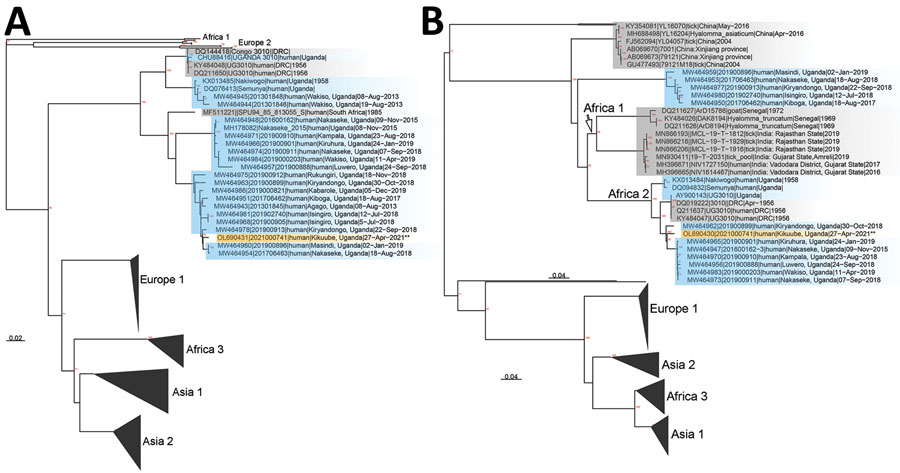Volume 28, Number 11—November 2022
Dispatch
Crimean-Congo Hemorrhagic Fever Outbreak in Refugee Settlement during COVID-19 Pandemic, Uganda, April 2021
Figure 2

Figure 2. Phylogenetic analysis of all available full-length Crimean-Congo hemorrhagic fever (CCHF) small (A) and medium (B) segments from GenBank. Orange shading indicates sequence from 16-year-old girl in 2022; blue shading indicates past sequences from Uganda; gray shading indicates non-Uganda sequences. Major clades are labeled according to Balinandi et al. (6). Nodes with bootstrap support >70% are labeled in red. GenBank accession numbers are OL690430–1.
References
- Gürbüz Y, Sencan I, Oztürk B, Tütüncü E. A case of nosocomial transmission of Crimean-Congo hemorrhagic fever from patient to patient. Int J Infect Dis. 2009;13:e105–7. DOIPubMedGoogle Scholar
- Messina JP, Pigott DM, Golding N, Duda KA, Brownstein JS, Weiss DJ, et al. The global distribution of Crimean-Congo hemorrhagic fever. Trans R Soc Trop Med Hyg. 2015;109:503–13. DOIPubMedGoogle Scholar
- Balinandi S, Patel K, Ojwang J, Kyondo J, Mulei S, Tumusiime A, et al. Investigation of an isolated case of human Crimean-Congo hemorrhagic fever in Central Uganda, 2015. Int J Infect Dis. 2018;68:88–93. DOIPubMedGoogle Scholar
- Kizito S, Okello PE, Kwesiga B, Nyakarahuka L, Balinandi S, Mulei S, et al. Notes from the field: Crimean-Congo hemorrhagic fever outbreak—Central Uganda, August–September 2017. MMWR Morb Mortal Wkly Rep. 2018;67:646–7. DOIPubMedGoogle Scholar
- Mirembe BB, Musewa A, Kadobera D, Kisaakye E, Birungi D, Eurien D, et al. Sporadic outbreaks of crimean-congo haemorrhagic fever in Uganda, July 2018-January 2019. PLoS Negl Trop Dis. 2021;15:
e0009213 . DOIPubMedGoogle Scholar - Balinandi S, Whitmer S, Mulei S, Nyakarahuka L, Tumusiime A, Kyondo J, et al. Clinical and molecular epidemiology of Crimean-Congo hemorrhagic fever in humans in Uganda, 2013–2019. Am J Trop Med Hyg. 2021;106:88–98. DOIPubMedGoogle Scholar
- Balinandi S, von Brömssen C, Tumusiime A, Kyondo J, Kwon H, Monteil VM, et al. Serological and molecular study of Crimean-Congo Hemorrhagic Fever Virus in cattle from selected districts in Uganda. J Virol Methods. 2021;290:
114075 . DOIPubMedGoogle Scholar - Paessler S, Walker DH. Pathogenesis of the viral hemorrhagic fevers. Annu Rev Pathol. 2013;8:411–40. DOIPubMedGoogle Scholar
- Shepherd AJ, Swanepoel R, Leman PA. Antibody response in Crimean-Congo hemorrhagic fever. Rev Infect Dis. 1989;11(Suppl 4):S801–6. DOIPubMedGoogle Scholar
Page created: September 06, 2022
Page updated: October 24, 2022
Page reviewed: October 24, 2022
The conclusions, findings, and opinions expressed by authors contributing to this journal do not necessarily reflect the official position of the U.S. Department of Health and Human Services, the Public Health Service, the Centers for Disease Control and Prevention, or the authors' affiliated institutions. Use of trade names is for identification only and does not imply endorsement by any of the groups named above.